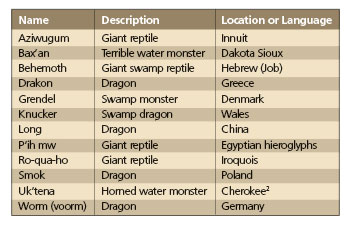"Look now at the behemoth, which I made along with you; he eats grass like an ox. See now, his strength is in his hips, and his power is in his stomach muscles. He moves his tail like a cedar; the sinews of his thighs are tightly knit. His bones are like beams of bronze, his ribs like bars of iron." (Job 40:15-18)
How do dinosaurs fit with the Bible’s history? They certainly existed—their fossil remains are found on every continent. And ancient historical records, including the Bible, chronicle human encounters with large reptiles whose descriptions best match dinosaurs. Could it be that these records show that dinosaurs and humans shared the earth at one time rather than living millions of years apart as evolutionary myth proclaims?
Dinosaurs certainly appear to be extinct now. Those that lived at the time of Noah’s globe-covering Flood drowned or suffocated (except those on board the Ark), as did all land-dwelling creatures with nostrils, according to Genesis 7:22. Fast-moving Flood mud quickly buried some of those outside the Ark. The mud layers covered the creatures’ dead bodies so deeply that scavengers couldn’t reach them, and the mud dried soon enough to preserve their remains as fossils faster than their carcasses could decay. Most, if not all, dinosaur fossil layers also contain fossil water creatures like fish and clams, and this fits the Flood explanation for their demise.
Although researchers have named hundreds of dinosaur species, all of them belong to only about 60 distinct families. These roughly equal the basic dinosaur kinds. That means Noah and his family only had to manage around 120 individual dinosaurs on the Ark. Could they all fit on board a vessel with the dimensions from Genesis 6? No matter how large some dinosaurs grew, the largest dinosaur egg wasn’t much bigger than a football. Even the Argentinosaurus, which could grow into a 120-foot-long monster, could have fit on the Ark if a younger and much smaller representative boarded the vessel. In contrast, many dinosaurs were small even when fully grown. For example, the compsognathids stood about as tall as a turkey. The average dinosaur size was about the same as a bison. One hundred-twenty bison would require a mere corner of one of the Ark’s three spacious decks.
We can infer from the reliable Genesis record that the descendants of the dinosaurs preserved on the Ark traveled from the Middle East to places around the globe. This makes sense when considering the unique post-Flood climate. The Ice Age occurred right after, and because of, the Genesis Flood. At that time the Middle East was tropical and regularly watered by heavy rains. This set up suitable and reachable environments for dinosaurs and other tropical creatures to fill. Various clues—such as dinosaur fossils buried alongside tropical plant fossils and the swampy setting that God describes for behemoth in Job 40—indicate many dinosaurs lived in very wet habitats.
This worldwide dinosaur migration happened only thousands of years ago. Adding the Bible’s time-stamped events from the fall of Jerusalem in 587 B.C. back to the Flood yields a date for the Flood either near 3168 or 2518 B.C., depending on manuscript variations.1 How long did dinosaurs live after the Flood, and why are they not living today?
Although creatures like dinosaurs scattered across Earth’s surface after the Flood, the first few generations of people determined to rebel against God’s command to fill the earth. Instead, they built a tower in Babel and remained in its growing city. In response, God supernaturally compelled them to disperse by confounding their languages. When families eventually migrated to far-flung places, they encountered the dinosaurs that had been there for a few centuries. Writings, depictions, and legends from people groups across the globe memorialized many of those encounters. As humans filled the post-Flood earth, dinosaur numbers would have dwindled due to hunting and loss of habitat as the Ice Age began to wane. The changing climate alone may have ultimately rendered the earth inhospitable to many of these creatures, eventually leading to their extinction. Even so, dinosaurs must have been living at least within the last several centuries, judging by the many tales of human encounters with them.
 The sheer number of names given to dragons, or dinosaurs, worldwide builds a strong argument that dragon legends reflect encounters with real creatures. Most languages, either in written or spoken form, have their own unique terms. The word “dragon” here doesn’t necessarily refer to popular images of a bulky, fire-breathing reptile that somehow flies with tiny wings. Rather, it can mean one of the many kinds of post-Flood dinosaurs, or even flying reptiles. Some languages still use words like those shown in this table. Wikipedia lists many more “dragon” names, at least some of which probably refer to actual giant reptiles including dinosaurs.3
The sheer number of names given to dragons, or dinosaurs, worldwide builds a strong argument that dragon legends reflect encounters with real creatures. Most languages, either in written or spoken form, have their own unique terms. The word “dragon” here doesn’t necessarily refer to popular images of a bulky, fire-breathing reptile that somehow flies with tiny wings. Rather, it can mean one of the many kinds of post-Flood dinosaurs, or even flying reptiles. Some languages still use words like those shown in this table. Wikipedia lists many more “dragon” names, at least some of which probably refer to actual giant reptiles including dinosaurs.3
Ancient historians described dragons as real, living creatures, listing them right alongside their descriptions of other creatures familiar to today’s readers. For example, in his book Natural History written in approximately 78 A.D., Pliny the Elder wrote that “it is India which produces the largest [elephants] as well as the dragon…and [the dragon] is itself of such enormous size as to envelop the elephants with its folds.”
During that same era, Flavius Philostratus wrote:
The whole of India is girt with dragons of enormous size; for not only the marshes are full of them, but the mountains as well, and there is not a single ridge without one. Now the marsh kind are sluggish in their habits and are thirty cubits long, and they have no crest standing up on their heads.4
Such accounts sprinkle the pages of history. Alexander the Great wrote of a large serpent his army encountered during one of their conquering excursions. The explorer Marco Polo also described one in his logbooks. Although these probably referenced giant snakes and not dragons, they illustrate that giant reptiles once lived where they are long gone today. Bill Cooper’s book After the Flood describes similar accounts from Europe. Cooper relayed a report written in 1484 by England’s first printer, William Caxton, of a singular creature:
About the marches [marshes] of Italy, within a meadow, was sometime a serpent of wonderful and right marvelous greatness, right hideous and fearful. For first he had a head greater than the head of a calf. Secondly, he had a neck greater than the length of an ass, and his body made after the likeness of a dog. And his tail was wonderfully great, thick and long, without comparison to any other.5
The creature thus described matches Job’s behemoth, which had a “tail like a cedar,” lived in a marsh where it ate reeds, and as “the first of the ways of God” was obviously quite large.6
People groups that did not maintain written records nevertheless retain oral traditions of dragon encounters. They describe the dragons’ habitats and habits and provide specific names for the dragons and the long-dead heroes who vanquished them. Towns, hillsides, and ponds across Europe still have old dragon names—such as Drachenfels Castle and the town of Worms in Germany, Grindelwald in Switzerland, Dragon-hoard (near Garsington), plus the Peak District’s Grindleford in England, and many others.
But even more evidence shows that early peoples encountered dinosaurs. Carvings, sculptures, bas reliefs, paintings, mosaics, tapestries, sculptures, pictographs, and petroglyphs all over the world depict dragons, and many of them look like specific dinosaurs. Some of the telling features that help identify these images as dinosaurian include horns, spiky skin flaps along the spine called dermal frills, long tails, long necks, large teeth, and, perhaps most importantly, legs that went straight down from the body. Today’s walking reptiles like crocodiles and lizards have legs that extend out from the sides of the body, then angle down to the ground at the elbows or knees. Dinosaur reptiles’ legs extended down, just as dozens of genuine, ancient depictions show.
Evolutionists assert that such dinosaur-looking artifacts are fakes. However, this objection doesn’t result from a rigorous analysis of the data. Instead, it stems from an argument that goes like this: “Dinosaurs died millions of years before man evolved, making it impossible for ancient men to know what dinosaurs looked like. Therefore, this artifact must be a fraud.” This kind of argument takes as true the very evolutionary history that the artifacts challenge. Ignoring evidence often leads to wrong conclusions.
The late cosmologist and atheist Carl Sagan considered the historical evidence for dragons a serious enough threat to evolutionary history that he tried to explain them in his 1977 book The Dragons of Eden. In it, he speculated that unknown human ancestor primates may have encountered dinosaurs millions of years ago. Supposedly, the “memories” of those terrifying encounters so deeply traumatized those primates that they left indelible, heritable stamps in their genes. Eons later, ancient ape-like human descendants drew dinosaur look-alike pictures from those inherited memories. But no scientific evidence whatsoever suggests that memories can be genetically inherited! Knowing this, many scientists at the time shunned Sagan’s unscientific speculation. But it is equally unscientific for those scientists to assert that myriad dragon legends are all fraudulent without even investigating the historical evidence.
If the Bible is correct that representatives of all land-dwelling, air-breathing creatures were on the Ark, and if it is correct in describing an Ice Age dinosaur in the book of Job, then it makes sense to infer that people encountered (and rid themselves of) the threatening and fearsome reptiles during the centuries after the Flood. They left us dragon legends—written, spoken, painted, and carved—from virtually every ancient culture. Genuine dinosaur encounters best explain the sheer number of dragon descriptions and their similarities across space and time.
References
- Thomas, B. 2017. Two date range options for Noah’s Flood. Journal of Creation. 31 (1): 120-127.
- Thomas, B. 2010. Oblivious to the obvious: dragons lived with American Indians. A review of Fossil Legends of the First Americans by Adrienne Mayor. Journal of Creation. 24 (1): 32-34.
- List of dragons in mythology and folklore. Wikipedia. Accessed August 1, 2012.
- Flavius Philostratus (c170-c247 A.D.). 1912. The Life of Apollonius of Tyana, volume I, book III. F. C. Conybeare, trans. New York: Macmillan Co., 243-247.
- Caxton, W. M. 1484. Aesop. Folio 138. Cited in Cooper, W. 1995. After the Flood. Chichester, UK: New Wine Press.
- Job 40:15-24.
Adapted from “Dinosaurs and Dragon Legends” in Creation Basics & Beyond: An In-Depth Look at Science, Origins, and Evolution.
* Mr. Thomas is Science Writer at the Institute for Creation Research and earned his M.S. in biotechnology from Stephen F. Austin State University.














